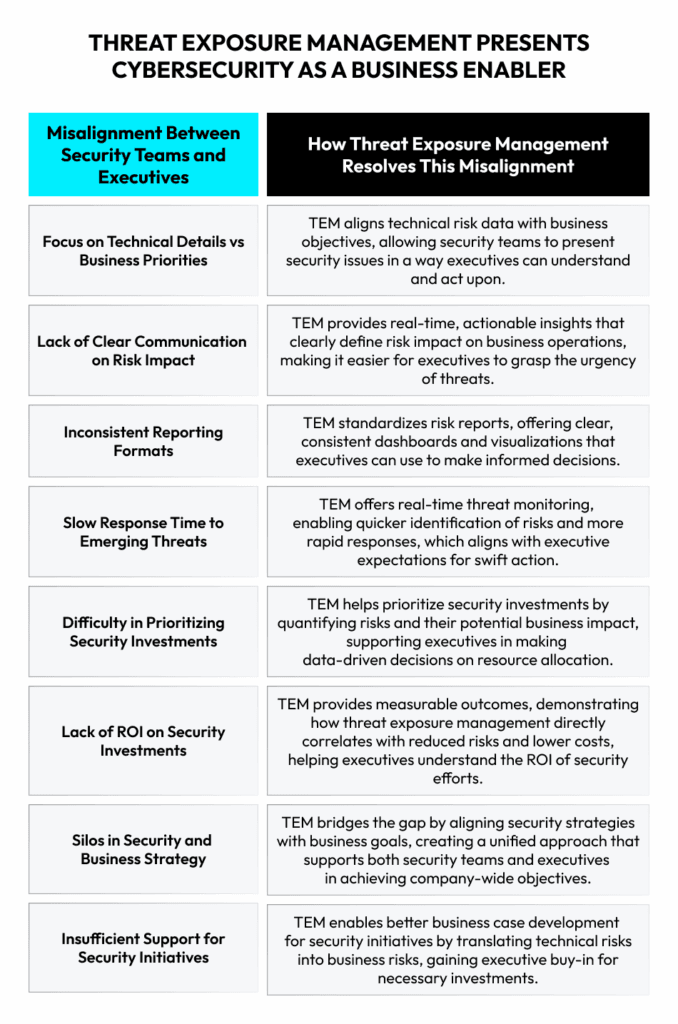Threat exposure management is a proactive, holistic approach aiming to identify, assess, and reduce your organization’s cyber risk. This is achieved by understanding its attack surface from a threat actor’s perspective and has recently evolved into CTEM (continuous threat exposure management), ensuring an always-on, resilient security posture.
As such, it directly addresses the three critical challenges that plague modern enterprises:
- Gaining comprehensive visibility across complex IT environments
- Prioritizing the remediation of a large volume of security exposures
- Bridging the communication gap between technical security teams and business leadership
This article explains exactly how threat exposure management solves these three key challenges.
1. Fragmented or Incomplete Attack Surface Visibility
Knowing your assets and their security issues seems basic. Yet, a lack of cybersecurity visibility—leaving organizations exposed to stacks of unmanaged cyber threats—is one of the biggest and most common problems today.
How Big of a Problem is the Lack of Cybersecurity Visibility?
Contemporary organizations usually operate incredibly complex and distributed IT environments, spanning:
- On-premise systems
- Multiple cloud providers
- SaaS applications
- IoT devices
- Mobile devices
- OT environments
- Built and test environments
- APIs
- Shadow IT
- Software supply chains
- Legacy software
This sprawl, in most cases, results in fragmented or incomplete visibility into digital assets and risk exposure.
Security teams struggle to see all the potential entry points and attack paths or understand the close-knit interconnectedness of their systems. That is especially true for third-party integrations, which often include chained dependencies—applications relying on a stack of software frameworks, libraries, packages, or modules, such as .NET, React, OpenCV, or Log4J.
This state cannot help but lead to critical blind spots that adversaries can capitalize on and readily exploit. It’s hard enough to manage exposure in known assets, considering the sheer volume of possible security weaknesses today. You don’t want, on top of that, to have the problem of unmanaged vulnerabilities and misconfigurations in unknown assets.
How Does Threat Exposure Management Help with Visibility?
Continuous discovery of your organization’s assets, regardless of where they reside, is the sine qua non of threat exposure management, especially in the form of CTEM. Hence, enabling you to create an inventory of all assets, cloud or on-prem, is one of its main objectives.
Asset Visibility is Not Enough: You Need Exposure Visibility
Needless to say, full environment visibility doesn’t consist entirely of an updated knowledge of your organization’s assets. It must include the mapping of your entire attack surface or it won’t do much good.
But the attack surface is not just CVEs and technical vulnerabilities like arbitrary code injections, and exposure management knows that very well. That is why it hunts for and strives to address all types of critical security weaknesses, i.e., exposures, proactively. These weaknesses include:
- Misconfigurations: unnecessary opened ports and exposed remote desktop protocols
- Weak access controls and excessive permissions: default passwords and insufficient MFA (multi-factor authentication)
- Exposed sensitive data: secrets in code repositories and developer environments with real data
- Business logic flaws: insufficient server-side validation and inadequate handling of unconventional input values
- Software supply chain risks: compromised software updates and vulnerable open-source components
Threat Exposure Management as an Orchestration Hub
Threat exposure management acts as an orchestration hub, employing a range of security tools, methods, and techniques to help you achieve full visibility. Key examples include:
- Offensive security testing, that is, penetration testing, BAS (breach and attack simulation), and red teaming, the latter being especially valuable since it emulates targeted cyberattacks specific to your environment and industry vertical, leading to the discovery of exploitable attack paths before adversaries do.
- Discovery and inventory solutions, like EASM (external attack surface management) and CAASM (cyber asset attack surface management) tools, as well as more traditional network scanners and asset management systems.
- Continuous monitoring and feedback loops, like workload protection and runtime exposure mitigation platforms, SIEMs (security information and event management), and SOARs (security orchestration, automation, and response).
2. Exposure Overload: Difficulty in Prioritizing Remediation Efforts
Many organizations struggle with prioritizing remediation due to an overreliance on inadequate scoring systems and a narrow focus that fails to capture true business risk.
The Problem of Exposure Overload, and Why Vulnerability Management Can’t Fix It
The number of newly published CVE records in 2024 was 40,077. And that’s only one year. What about the CVEs from previous years, especially considering that threat actors often exploit older unpatched vulnerabilities with publicly available exploits?
Your organization doesn’t have to suffer from every single new vulnerability published each year. Still, the factual state is that businesses, especially large enterprises, often have backlogs of hundreds of thousands of accumulated vulnerabilities. The truth is that fixing all of these is impossible, and you must prioritize the most critical ones.
You’d think traditional vulnerability management would allow you to deal with these—after all, it’s vulnerability management. However, it’s not as effective as we’d want it to be. So, what’s missing in vulnerability management?
The answer is that it’s stuck prioritizing remediation based on CVSS scores. The higher the score, the higher the priority. However, this can be a highly inefficient method of dealing with security risk because:
- CVSS scores lack context.
A CVSS score sometimes says nothing about the exploitability of a vulnerability or its actual impact on your organization and vertical. For instance, a vulnerability with a score of 9 suggests it’s severe. However, if it’s in a non-critical internal tool that doesn’t handle sensitive data, its potential impact is far lower than the score suggests.
Similarly, a vulnerability in a web application with a high CVSS score poses a low actual risk if the application is behind a firewall and only accessible via a VPN, as attackers would need additional steps to reach the vulnerable system.
In contrast, a vulnerability in a customer-facing application with highly sensitive data might be critical in a business context, even if it has a low CVSS score.
- Not all security weaknesses can have CVSS scores, since threat exposure is not identical to vulnerabilities.
A clear example is an employee using an unauthorized, personal cloud storage service (like a free tier of Dropbox or Google Drive) to store confidential company documents.
In this case, there’s no specific vulnerability in a piece of software or hardware that you can point to and assign a CVE ID. The exposure arises from the misuse or mismanagement of a legitimate service within a specific organizational context.
The security risk doesn’t lie in a technical flaw of Dropbox but in the violation of company policy, lack of centralized control, the potential for data leakage, and the absence of a corporate security control (access logging or similar). Essentially, it’s about data governance, making it hard to apply CVSS metrics to something like an employee saving a file to a personal cloud drive.
Downsides like these lead to irrelevant remediation prioritization efforts and a waste of time and resources. Even if vulnerability management were absolutely successful in addressing vulnerabilities, you would still be highly susceptible to cyberattacks due to the many other exposures left unaddressed.
Risk- and Context-Based Prioritization as a Solution
Threat exposure management fixes these downsides by:
- Going much further than CVE vulnerabilities alone, as we’ve already mentioned in the previous section.
- Adopting risk-based and context-based prioritization.
Risk-based prioritization means determining what matters most to your organization if it’s compromised, and how likely that compromise is. Threat exposure management moves beyond listing exposures to actually quantifying and ranking their true risk to the organization.
Context-based prioritization is inextricably linked to risk-based prioritization. To accurately perform risk-based prioritization, exposure management relies on context-based prioritization. That allows it to answer burning questions about:
- Asset criticality: Is the affected asset a critical production server or a development test environment?
- Network exposure: Is the exposure internet-facing or internal?
- Threat intelligence: Is there an active exploit in the wild for this specific vulnerability? Are threat actors targeting this type of system?
- Attack path analysis: Does this exposure create a direct, exploitable path to a “crown jewel” in your environment?
- Compensating controls: Are there any security layers that mitigate the risk?
The whole point is to help you understand the relationships between the weaknesses and operational impact, as well as whether adversaries can chain multiple weaknesses together. This last phenomenon is becoming more and more pronounced in attack path analysis, considering that vulnerability chaining is increasingly popular among adversaries.
This way, exposure management enables you to:
- Allocate resource strategically
- Focus on relevant, actual threats
- Improve decision-making
- Take a markedly proactive security approach
- Improve communication with stakeholders
Mitigate First, Manage Later
Since the point of prioritizing vulnerabilities and exposures is more effective and faster remediation, it’s worth noting that a new mitigation-first approach is driving CTEM forward so that exposures are addressed even more efficiently.
Workload patchless mitigation flips the script of standard exposure management: It applies mitigation immediately as the first step in reducing exposure. As counter-intuitive as it sounds, it means mitigation precedes even exposure prioritization and assessment. Again, it’s the very first step in reducing your attack surface.
Mitigation-first as a form of remediation is the most efficient way to address threat exposure for the following reasons:
- You don’t depend on patching cycles, the processes of which are known for being too long and cumbersome.
- Patching or, generally, removing the root cause of a problem, is impracticable in many cases such as when there are business-critical legacy software, zero days, or too many vulnerabilities.
- Even if patching is streamlined and practicable, there’s still a window of opportunity between the discovery of a vulnerability and its patching for attackers to exploit this security weakness.
It’s important to understand that patchless mitigation doesn’t make exposure prioritization, assessment, and identification dispensable. It protects your assets through certain mechanisms, such as autonomous application control in just-in-time access; but you’d still want to remove the root causes of your most critical security issues where applicable.
In those cases, it has your back while you’re devising and applying permanent solutions. On the other hand, in cases where a permanent solution is impracticable or impossible, like in legacy systems, it can be both your first and last line of defense for as long as you need.
3. Ineffective Communication of Cyber Risk to Business Leaders
Beyond the technical complexities, one of the most enduring hurdles for cybersecurity programs lies in effectively communicating the tangible business implications of cyber risk to non-technical leaders.
The Problem with Communicating Cyber Risk
When security professionals “speak technical”, their language typically fails to resonate with executives. The reasons are the following:
- The primary concerns of decision-makers revolve strictly around business operations, financial performance, market reputation, and strategic growth
- Most executives do not have a technical background
- The business implications of cybersecurity issues are not immediately apparent
This situation can only lead to a lack of buy-in for crucial security initiatives. Security budgets are insufficient, critical projects are deprioritized, and cybersecurity is perceived as a cost center (rather than a business enabler) each time when executives cannot see the business impact of cyber risks clearly.
In other words, the inability to articulate how a security exposure directly threatens revenue, customer trust, or operational continuity leaves your security team struggling for resources and executive attention.
How Does Threat Exposure Management Help with Communication?
Threat exposure management fundamentally changes the way executives perceive cyber risk by making business impact a central criterion for prioritizing remediation. It allows security teams to demonstrate how potential threats and exposures could impact critical business functions, revenue streams, or organizational reputation, translating technical security data into tangible business value.
By focusing on risk-based and context-based prioritization, threat exposure management quantifies and visualizes cyber threats in terms of actual business impact. It shows the:
- Critical business applications or data at risk
- Potential financial losses from a breach
- Operational downtime or reputational damage that could result
- Direct attack paths to an organization’s crown jewels
This way, it allows for meaningful conversations with leadership, cultivating a shared understanding of cyber risk across the entire organization. When executives see that security investments protect the business directly, this understanding leads to better alignment, increased strategic funding, and a stronger, more resilient security posture.

Conclusions
Threat exposure management provides a holistic solution to the most burning contemporary cybersecurity issues:
- It eliminates critical blind spots by delivering full visibility into a sprawling and complex IT landscape.
- It enables security teams to manage exposure overload effectively, focusing remediation efforts where they matter most.
- It translates security risk into actual business impact, ultimately helping everyone to be on the same page and promoting cybersecurity investments.
Book a demo: Experience threat exposure management done right with workload patchless mitigation.
FAQs
Traditional vulnerability management primarily focuses on technical vulnerabilities (CVEs), whose criticality is based solely on CVSS scores.
Threat exposure management, in contrast, includes all types of security exposures—misconfigurations, shadow IT, business logic flaws, supply chain risks, etc.—and prioritizes remediation based on actual risk and potential business impact instead of strictly technical severity.
Threat exposure management addresses this problem through risk- and context-based prioritization and a mitigation-first approach. It addresses exposures based on asset criticality, network exposure, threat intelligence, attack path potential, and available compensating controls. That leads to faster, more effective, and more efficient remediation.
Threat exposure management bridges this communication gap between security teams and executives by translating technical security data into a business-relevant context.
It quantifies and visualizes threats in terms of actual business impact, pointing to the potential financial losses, operational downtime, and reputational damage of adversaries exploiting exposures. That allows for meaningful conversations that resonate with leadership’s concerns about business operations and strategic growth.




